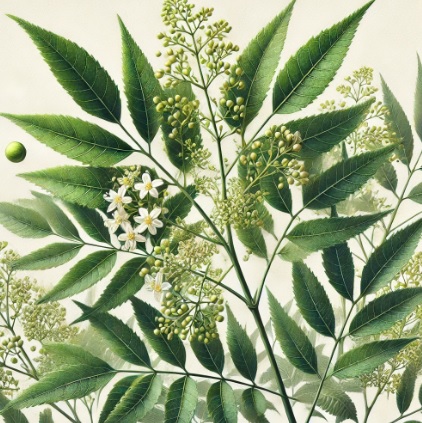Neem (Melia azadirachta), commonly known as the neem tree or Indian lilac, is a fast-growing, evergreen tree native to the Indian subcontinent and parts of Southeast Asia. It is widely recognized for its numerous medicinal properties, aromatic foliage, and ecological benefits. The neem tree is highly valued in traditional medicine, agriculture, and various industrial applications.
Botanical Classification:
Kingdom: Plantae
Order: Sapindales
Family: Meliaceae
Genus: Melia
Species: Melia azadirachta
Plant Characteristics:
Leaves: The neem tree has pinnate leaves that are alternately arranged and consist of 5-13 leaflets. The leaflets are typically dark green, glossy, and aromatic.
Flowers: The tree produces small, fragrant, white or pale yellow flowers that grow in dense clusters. The flowers are followed by fruit.
Fruit: The fruit is a drupe that turns from green to yellowish-brown upon ripening. It contains a single seed.
Growth Habit: Melia azadirachta can grow up to 15-20 meters in height. It has a broad, spreading canopy and a deep, extensive root system. It is tolerant of various soil types and climatic conditions.
Chemical Composition and Structure:
The chemical composition of Melia azadirachta includes:
Neem Oil: Contains active compounds such as azadirachtin, nimbin, and nimbolide, which contribute to its medicinal and pesticidal properties.
Flavonoids and Tannins: Present in leaves and seeds, providing antioxidant and astringent effects.
Essential Oils: Various terpenes contribute to the plant’s characteristic aroma and therapeutic properties.
Alkaloids: Includes compounds that have been studied for their potential pharmacological effects.
Uses and Benefits:
Medicinal: The neem tree is used in traditional medicine for its antibacterial, antifungal, antiviral, and anti-inflammatory properties. It is employed in the treatment of skin conditions, digestive disorders, and as a general tonic.
Cosmetic: Neem oil and extracts are widely used in skincare products for their antibacterial and anti-inflammatory properties. They help in treating acne, eczema, and other skin issues.
Agricultural: Neem oil is used as a natural pesticide and fungicide, helping in organic farming by controlling pests and diseases without harmful chemicals.
Environmental: The neem tree is known for its ability to improve soil quality and its role in reforestation and agroforestry projects. It helps in combating soil erosion and providing shade and habitat.
Applications:
Traditional Medicine: Utilized in various herbal remedies for its broad spectrum of therapeutic benefits, including treatments for skin diseases, gastrointestinal issues, and immune support.
Cosmetics: Neem oil and extracts are incorporated into skincare and haircare products for their beneficial effects on the skin and scalp.
Agriculture: Applied as a natural pesticide and fungicide in organic farming to control pests and enhance crop health.
Environmental: Planted for reforestation, soil improvement, and erosion control. It is also used in agroforestry systems for its ecological benefits.
Environmental and Safety Considerations:
Environmental Impact: Generally considered beneficial for the environment due to its ecological roles and sustainability in agroforestry and reforestation projects.
Safety: Neem oil and extracts are generally safe for topical use and consumption in recommended amounts. Individuals allergic to plants or with very sensitive skin should be cautious.
INCI:
Skin conditioning agent. It is the mainstay of topical skin treatment as it has the function of restoring, increasing or improving skin tolerance to external factors, including melanocyte tolerance. The most important function of the conditioning agent is to prevent skin dehydration, but the subject is rather complex and involves emollients and humectants that can be added in the formulation.
Antioxidant agent. Ingredient that counteracts oxidative stress and prevents cell damage. Free radicals, pathological inflammatory processes, reactive nitrogen species and reactive oxygen species are responsible for the ageing process and many diseases caused by oxidation.
Film-forming agent. It produces, upon application, a very thin continuous film with an optimal balance of cohesion, adhesion and stickiness on skin, hair or nails to counteract or limit damage from external phenomena such as chemicals, UV rays and pollution.
Synonyms:
CAS:
![]() Neem
Neem 
